We recently reviewed the OCZ Octane SSD in a 512GB capacity, one of the four capacity points offered by OCZ in the Octane family. For many SSD buyers though the 128GB capacity is the sweet spot, with the average consumer SSD capacity hovering near 150GB, 128GB SSDs offer a nice blend of capacity, performance and price. The 128GB Octane offers a SATA 6Gb/s interface and an Indilinx processor to drive read speeds up to 535MB/s, writes of 170 MB/s and random read 4KB IOPS of 37,000.
Like all Octane SSDs on the latest generation Indilinx Everest platform, the drives offer 512MB on onboard cache, 25nm Synchronous NAND and the software tools that operate in the background like nDurance and garbage collection. Octane SSDs are sold bare in a clear blister pack, and come with a standard 3 year warranty.
The 128GB Octane carries a street price of around $180, which puts it a little less expensive or near price parity (depending on promotions) with other same capacity offerings like the Plextor M3S, Crucial m4 and Samsung 830. It also puts the pricing in line with OCZ’s own high performance enthusiast SSD, the Vertex 3.
Other than a brief teardown, we will jump straight into benchmarks with this review. More background on the Octane may be found in our previously posted 512GB Octane review.
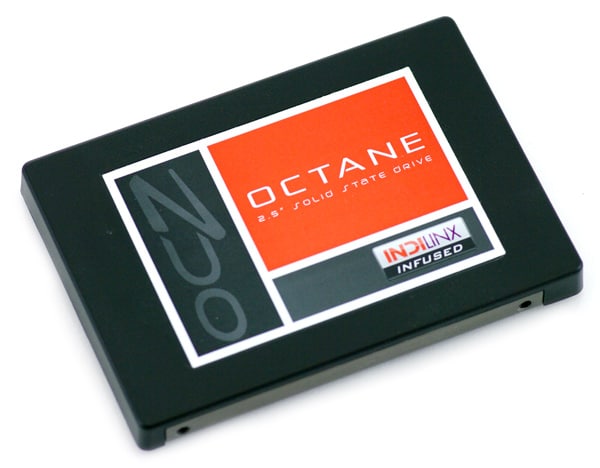
128GB OCZ Octane Specs
- 128GB (OCT1-25SAT3-128G)
- 128GB Formatted Capacity: 119.24GB
- Indilinx Everest platform
- Max Rad: up to 535 MB/s
- Max Write: up to 170MB/s
- Random Write 4KB: 7,700 IOPS
- Random Read 4KB: 37,000 IOPS
- 512MB Onboard Cache
- 25nm Intel Synchronous NAND
- TRIM Support
- SATA 6Gb/s interface
- NCQ Support up to 32 Queue Depth
- 9.5mm, 2.5″ form factor
- Dynamic & Static Wear-Leveling, and Background Garbage Collection
- 8 channels with up to 16-way Interleaving
- Power Consumption: 1.98W active, 1.15W standby
- Firmware Reviewed: E0882584
- Three year warranty
Disassembly
As a warning for those thinking about tearing into their new OCZ Octane, know that you will void your warranty in the process. Besides trying to get a physical confirmation on what the internals are, there really is no reason to open one of these up, especially when we take the risk for you. The OCZ Octane is very easy to take apart with a Phillips-head screwdriver. After removing four screws around the perimeter and breaking through the warranty sticker, the top cover comes loose exposing the PCB inside. The circuit board is held in place with four additional screws; the primary guts including the controller are on the other side of the PCB.
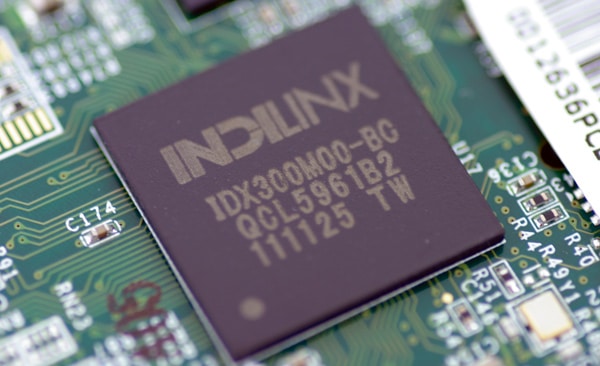
At the heart of the OCZ Octane SSD is the all new Indilinx IDX300M00-BC controller. Paired with this controller is 512MB of Micron DDR3 memory split up between two 256MB pieces top and bottom. The 128GB Octane still retains the full cache amount that its larger 512GB version also had.
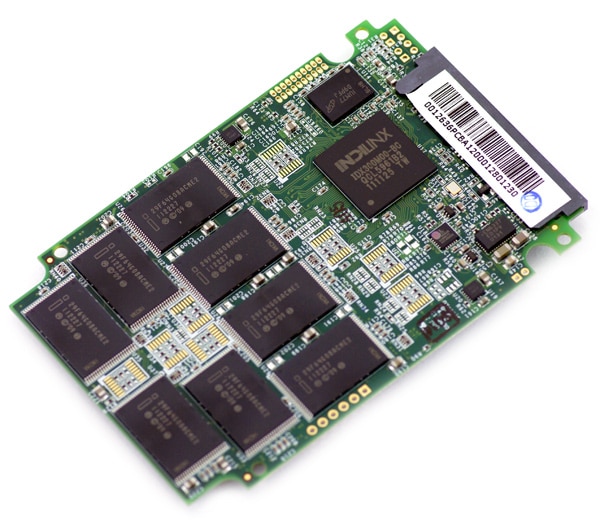
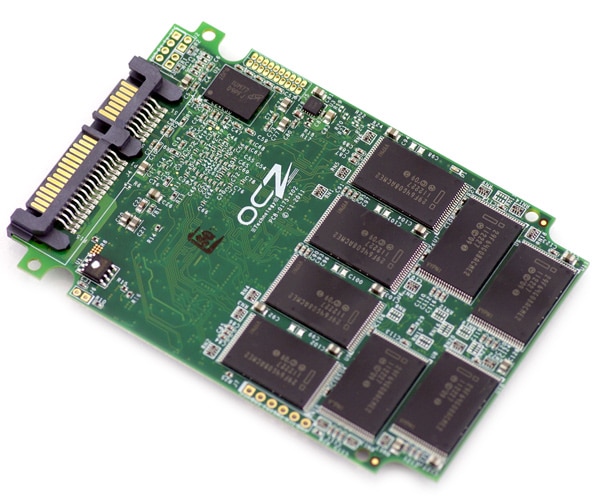
The 128GB Octane makes use of sixteen Intel 29F64G08ACME2 8GB 25nm synchronous NAND pieces. Eight are soldered onto each side with one 256MB RAM piece as well.
Synthetic Benchmarks
Compared to the 512GB OCZ Octane we reviewed previously, the 128GB version has slightly slower read speeds and much lower write speeds. Most SSDs have this type of performance difference, although with SandForce models the 240GB capacity is usually the sweet spot. OCZ specs the 128GB Octane with a read speed of 535MB/s and a write speed of 170MB/s. Below are our finding using IOMeter with a 2MB sequential transfer size.
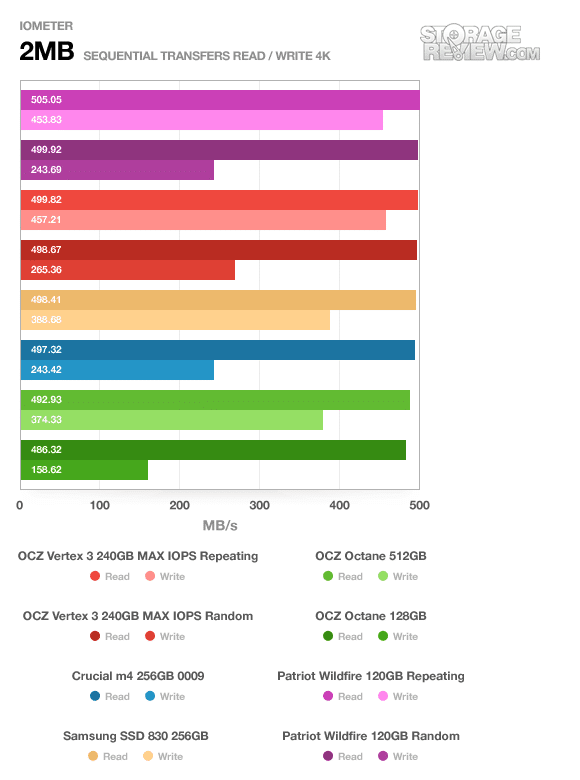
We measured a sustained read speed of 486MB/s read and a write speed of 158MB/s write (the 512GB model measured 492MB/s read and 374MB/s write). This put it on good ground with read speed compared to the other models we stacked it up against, although it had the slowest write speeds. By comparison the 120GB Patriot Wildfire measured 452MB/s write with repeating data and 243MB/s write with randomized data.
Our next test switches from sequential to random, keeping the 2MB transfer size.
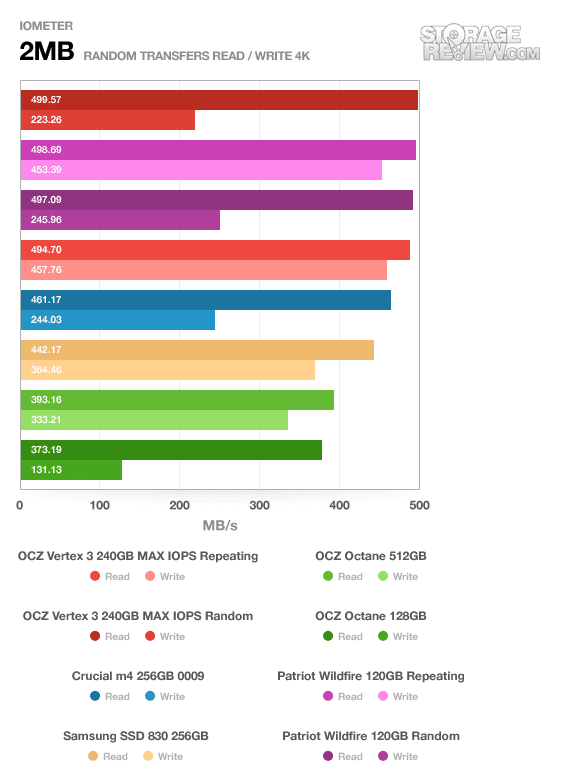
The 128GB Octane slowed to 373MB/s read and 131MB/s write in this test, while the 512GB model scored 393MB/s read and 333MB/s write. Both models scored towards the bottom in terms of read speed, with the 128GB Octane having roughly half the write speed of other models.
In our previous review of the Octane at the 512GB size, we noted the exceptionally strong 4K read speed the Indilinx controller provided. In our next group of tests we see how well the smaller capacity stacked up.
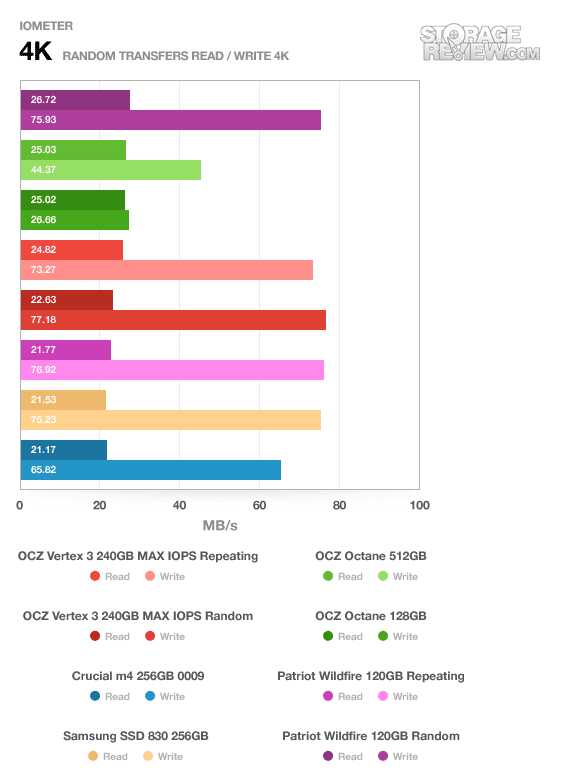
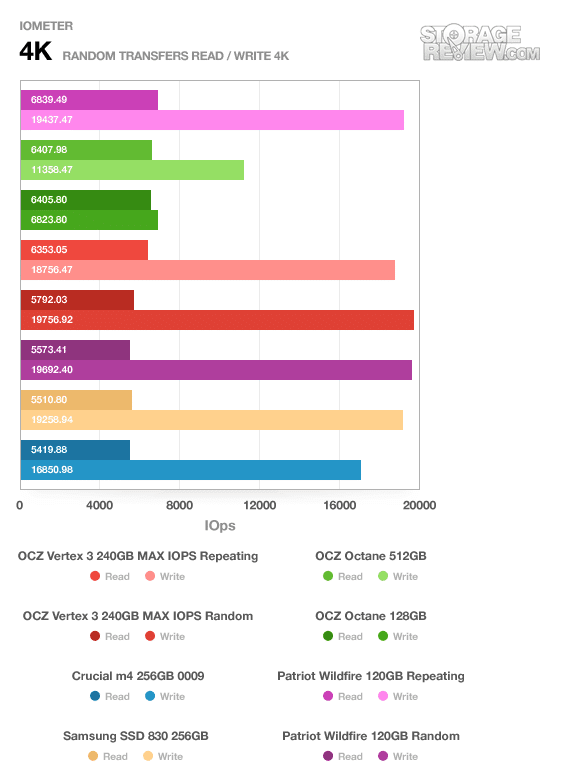
The 128GB Octane still came through swinging with strong QD1 4K random read speeds, measuring 25.02MB/s read or 6405IOPS. Write speeds though were much lower than the pack as well as under the 512GB Octane.
Pushing the queue depth past one into a multithreaded simulation, the 128GB Octane started to level off at QD16, but really started to slip behind the other models at QD4.
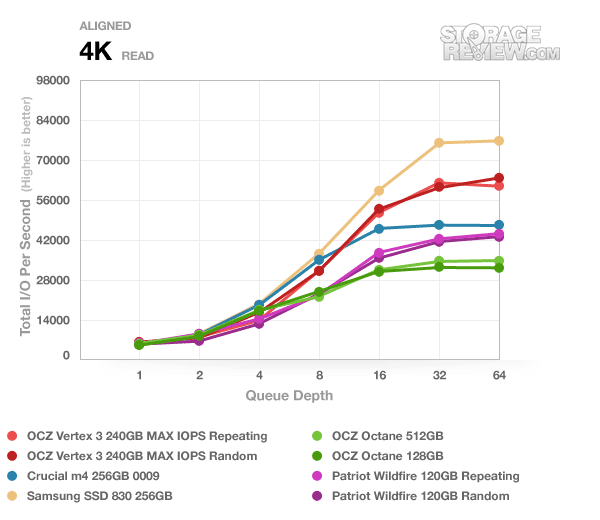
The expanded 4K write speeds weren’t really the Octane’s strong suit, staying well behind the for the duration of the test. One area to note though is under worst-case conditions with the Patriot Wildfire working with fully random data, it also scored similarly in the expanded 4k write test.
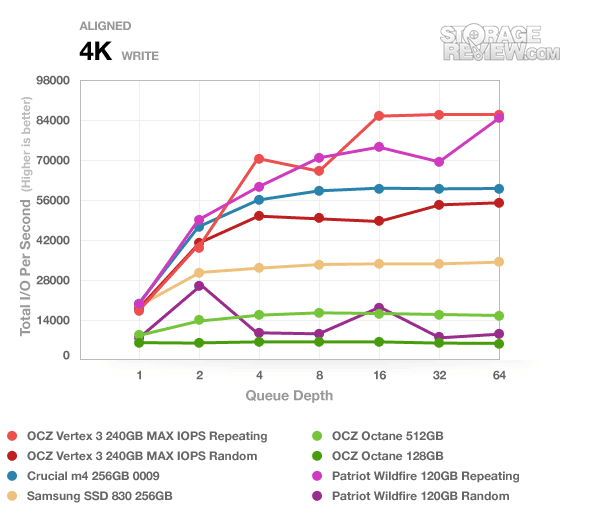
Given the slower random 4K write speeds, the 128GB Octane scored the slowest in the write latency test by a significant margin. It measured an average speed of 0.146ms with a max response time of 91ms. Indilinx’s main strength is definitely in read speeds.
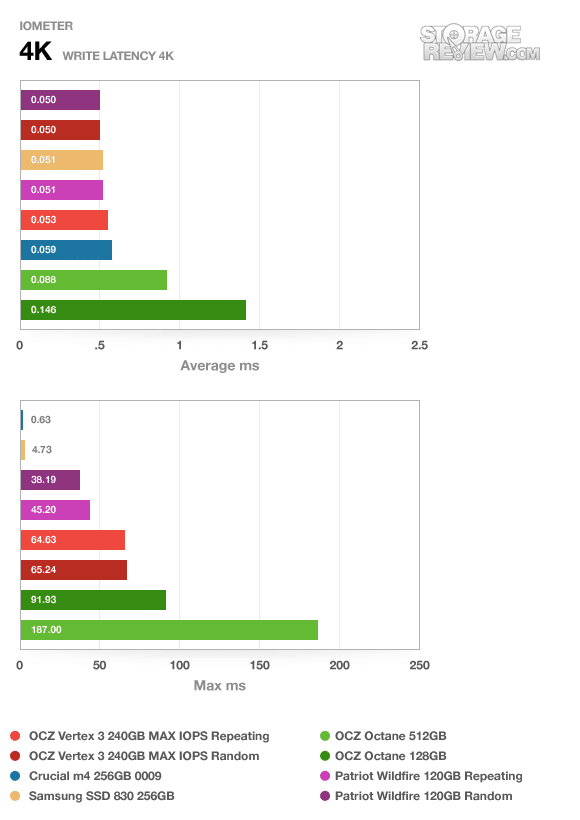
Using CrystalDiskMark we showed the 128GB OCZ Octane’s speed using fully random data. These speeds aligned closely with our IOMeter tests, although were slightly higher in their burst sequential measurements.
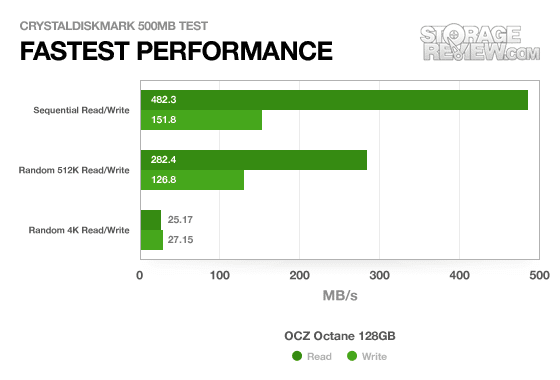
Our last section of standard synthetic benchmarks looks at server profiles including a Database, Workstation, Webserver, and File Server scenario. Surprisingly the Octane was able to pull ahead of the Crucial m4 in some situations at higher queue depths, although just barely.
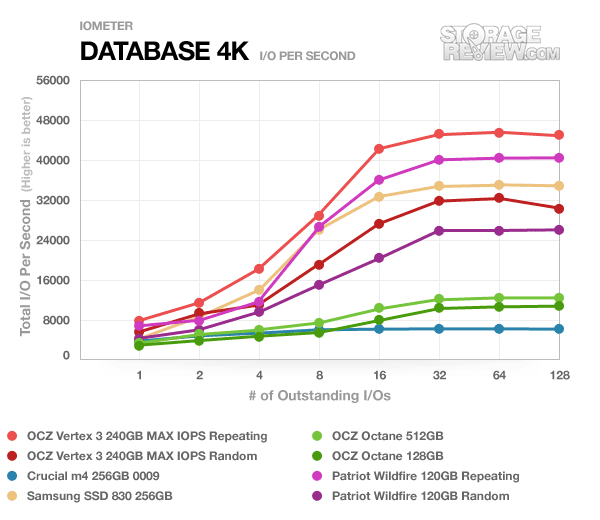
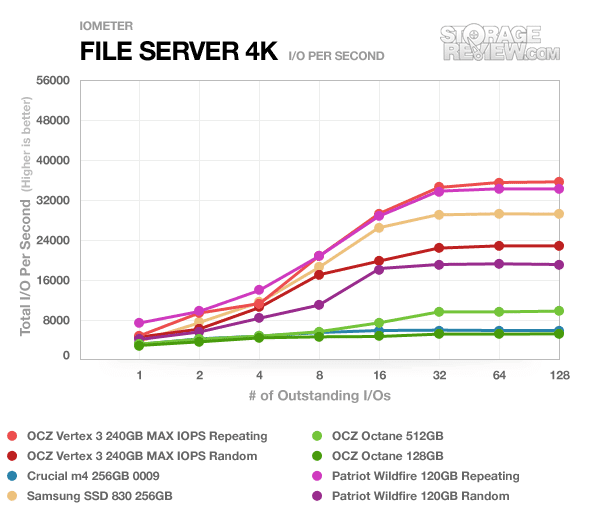
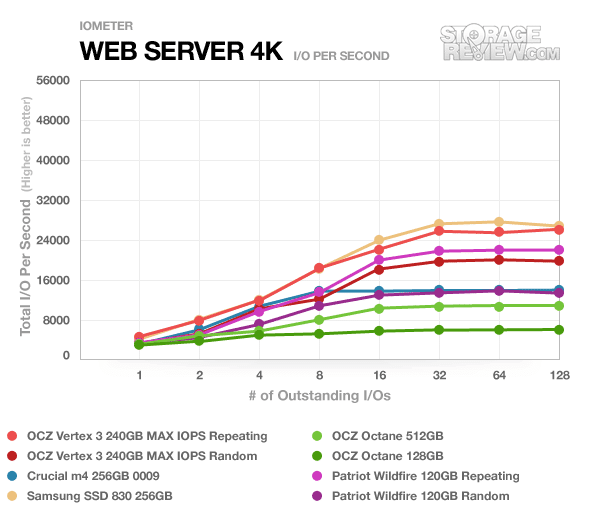
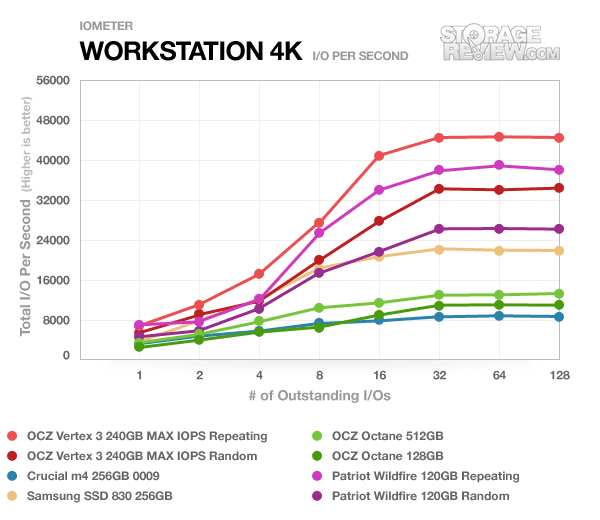
Enterprise Benchmarks
While we normally don’t include steady-state benchmarks in our consumer reviews, we felt it could offer some value to our readers to see how this drive might perform in an 24/7 continuous-write setting. Generally speaking only heavily-over provisioned drives can compete in this space, as well as models with heavy garbage collection algorithms that run at all times in the background to move around data as the drive fills up. Given this is our first look at this new platform and controller, we wanted to see how it stacked up in this space. The assortment of drives also compared includes the Micron C300 and P300 as well as the Plextor PX-M2P. The Micron P300 is the heavy-weight SLC-based enterprise drive in this test.
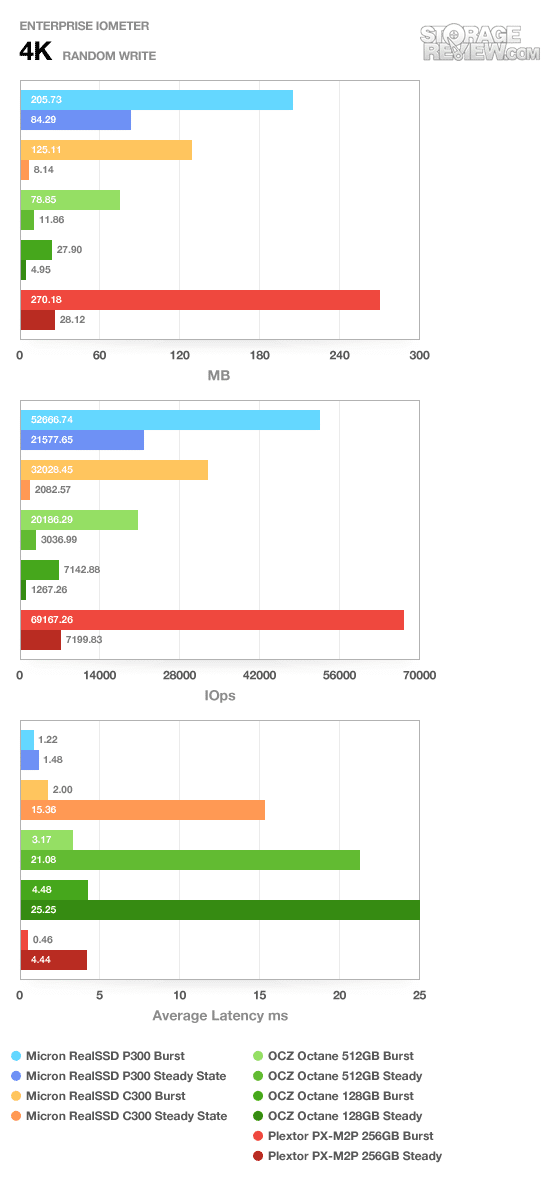
It’s a given that any drive put through the steady-state benchmark will have a significant performance drop between before and after. Comparing the consumer-targeted C300 to the enterprise-targeted P300, we notice a 60% drop on the P300 and 94.5% drop on the C300. Clearly the P300 held up better in a 24/7 write environment. The Plextor PX-M2P saw a performance drop of 89.6%, which fared better than the C300… not to mention had a faster peak speed to drop from. The 128GB OCZ Octane based around the Indilinx Everest platform saw a drop of 82.8%, with a starting speed of 27.9MB/s and an ending speed of 4.95MB/s.
Real World Benchmarks
If you are new to StorageReview, one thing we try to focus on is how any given drive might perform under real-world conditions. For the average user, trying to translate random 4K write speeds into an everyday situation is pretty difficult. It helps when comparing drives in every setting possible, but it doesn’t exactly work out into faster everyday usage or better game loading times. For this reason we turned to our StorageMark 2010 traces, which include HTPC, Productivity, and Gaming traces to help readers find out how a drive might rank under their conditions.
The first real-life test is our HTPC scenario. In this test we include: playing one 720P HD movie in Media Player Classic, one 480P SD movie playing in VLC, three movies downloading simultaneously through iTunes, and one 1080i HDTV stream being recorded through Windows Media Center over a 15 minute period. Higher IOps and MB/s rates with lower latency times are preferred. In this trace we recorded 2,986MB being written to the drive and 1,924MB being read.
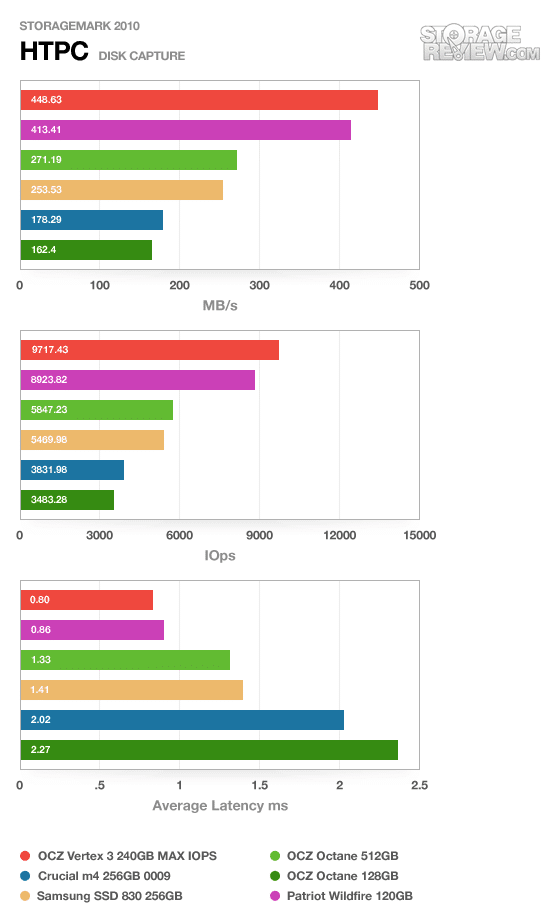
The 128GB Octane dropped 108MB/s compared to the 512GB model in our HTPC trace, scoring an average speed of 162.4MB/s.
Our second real-life test covers disk activity in a productivity scenario. For all intents and purposes this test shows drive performance under normal daily activity for most users. This test includes: a three hour period operating in an office productivity environment with 32-bit Vista running Outlook 2007 connected to an Exchange server, web browsing using Chrome and IE8, editing files within Office 2007, viewing PDFs in Adobe Reader, and an hour of local music playback with two hours of additional online music via Pandora. In this trace we recorded 4,830MB being written to the drive and 2,758MB being read.
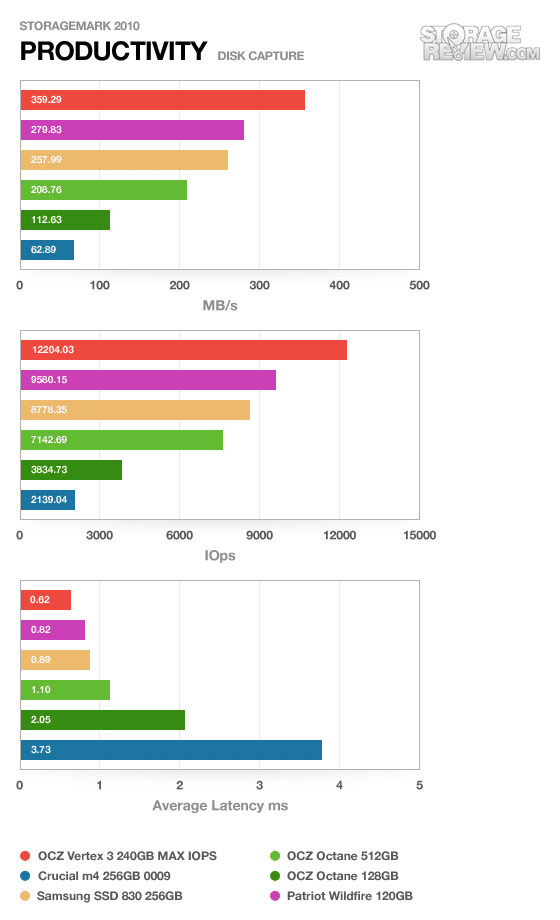
In the productivity trace the smaller Octane came through with almost a 50% reduction in speed, measuring 112MB/s average compared to 208MB/s of the larger version.
Our third real-life test covers disk activity in a gaming environment. Unlike the HTPC or Productivity trace, this one relies heavily on the read performance of a drive. To give a simple breakdown of read/write percentages, the HTPC test is 64% write, 36% read, the Productivity test is 59% write and 41% read, while the gaming trace is 6% write and 94% read. The test consists of a Windows 7 Ultimate 64-bit system pre-configured with Steam, with Grand Theft Auto 4, Left 4 Dead 2, and Mass Effect 2 already downloaded and installed. The trace captures the heavy read activity of each game loading from the start, as well as textures as the game progresses. In this trace we recorded 426MB being written to the drive and 7,235MB being read.
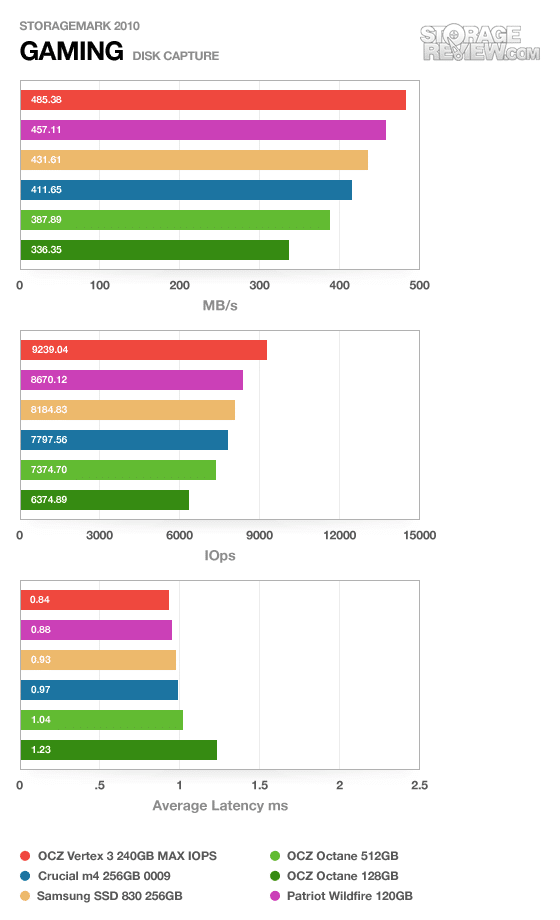
With the stronger read speed advantage of the smaller capacity Octane, the difference in capacities was not as pronounced as it was in other traces. In our Gaming trace we measured an average speed of 336MB/s on the 128GB model versus 387MB/s on the larger 512GB SSD.
Power Consumption
As a completely new platform, we had no idea how the Octane would perform in our power test. Looking past the controller differences, this 512GB as well as the others in its family all come equipped with 512MB of cache (some goes unused on smaller capacities) which can add to the power consumption of the drive. By comparison the SandForce SSDs go without add-on RAM cache and the Crucial m4 and Samsung SSD 830 use 256MB.
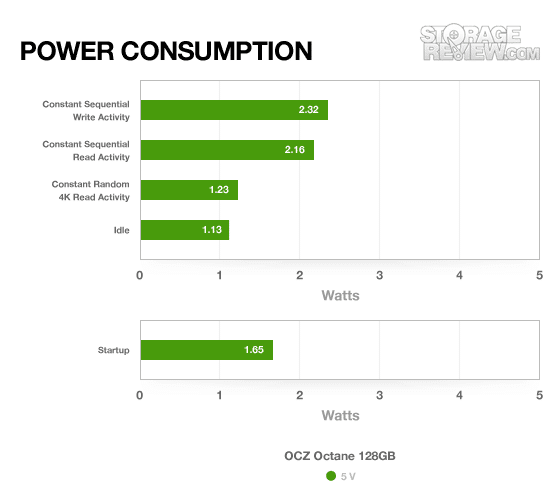
The smaller capacity 128GB Octane was much easier on our system than its larger 512GB brother, nearly halving the power requirements from our previous review. Wattage measured in the 2MB sequential write test measured just 2.32, compared to 4.55 on the 512GB model. Sequential read power values also dropped, although not as much as it did with write activity. Overall the power usage of the 128GB Octane is much better than it was on the 512GB capacity.
Warranty
OCZ provides a three year warranty for the Octane family of SSDs, which is in-line with other SSDs in this class, though a handful of drives do offer a five-year warranty.
Conclusion
The Indilinx processor gives OCZ a huge advantage in both cost savings and SSD reliability. When we look at the smaller 128GB Octane compared to the 512GB bigger brother, the 128’s read speeds actually hold up very well. Per the spec sheet though and based on our tests, the write speeds suffer dramatically. What this means in terms of practical usage really depends on the scenario. The Octane has always been positioned as a lower cost alternative in the mainstream SSD space, and when that’s true, users will be more concerned about reliability and price over topline speed. Areas that leverage read speeds like gaming for example, would still show strong performance, while items with intensive write profiles would slip compared with other SSDs.
The problem for the Octane right now however, is that the 120GB Vertex 3 carries a street price that’s lower than the Octane (both after rebates). There are many reasons for this, not the least of which is the Octane has been on the market for weeks, compared to the many months for the Vertex 3 line, and OCZ is yet to realize economies of scale when producing the Indilinx processors. That said, we do expect the Octane’s price to fall faster than competing drives in the market, which in turn will enhance its price per performance per gigabyte metric.
At the end of the day the 128GB Octane holds it own in lower queue depth 4K random read speeds and has no write speed disadvantage with incompressible data. That said though, many of the similarly priced SandForce SF-2200 offerings like the OCZ Vertex 3 offer similar benefits when you look incompressible data speeds.
Pros
- Maintains strong read speeds
- Good gaming performance
- Improved power consumption over 512GB capacity
Cons
- Price needs to fall more to be competitive
- Write speeds take a significant cut compared to 512GB model and competition
Bottom Line
The OCZ Octane 128GB does a great job of holding the line when it comes to strong read speeds and delivers better power consumption when compared to the larger 512GB Octane. The read speeds suffer though and the pricing is a bit askew at the moment. However once the Octane spends more time in the market and pricing closes in on $150, it’s a viable value/mainstream SSD offering.




 Amazon
Amazon